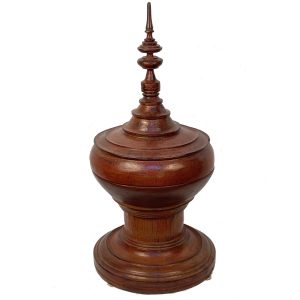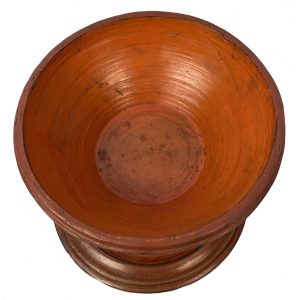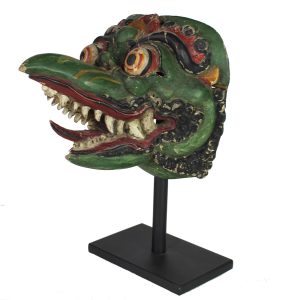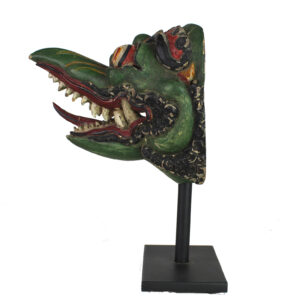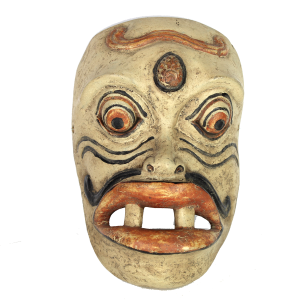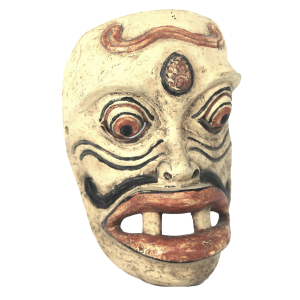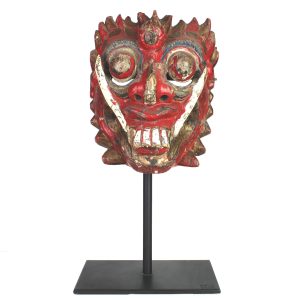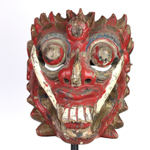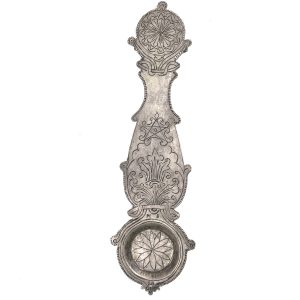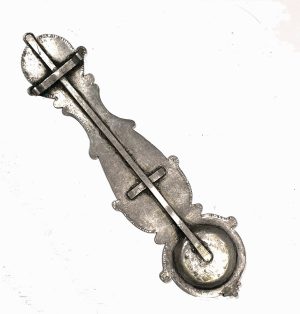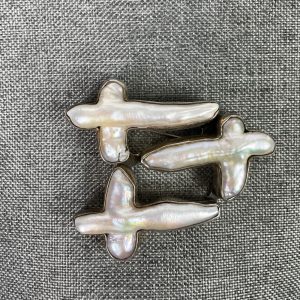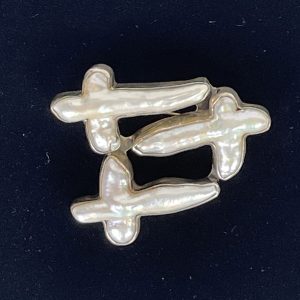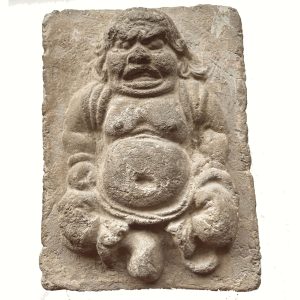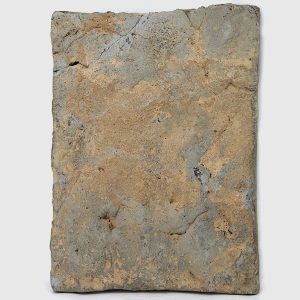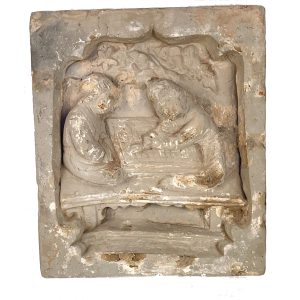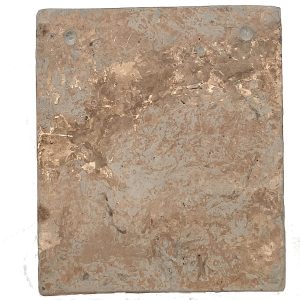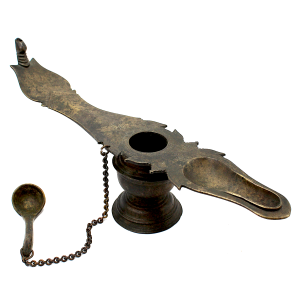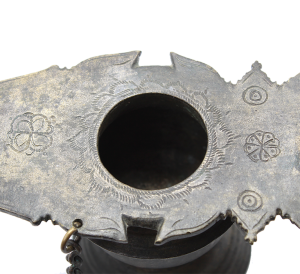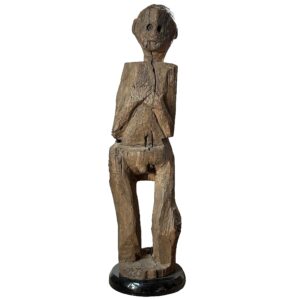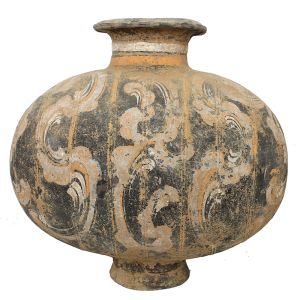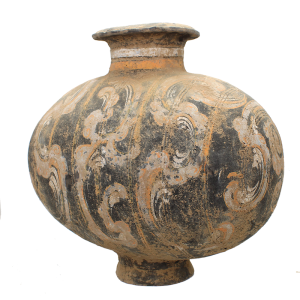Showing 49–60 of 99 results
-
Sale!


$725.00 Original price was: $725.00.$495.00Current price is: $495.00.
H: 26″ Dia: 12.5″|FOR SHIPPING INFORMATION CONTACT US AT 213-568-3030 OR EMAIL [email protected]
This elegant hsun-ok reveals much about the Burmese: their profound belief in Buddhism and commitment to support the monastic life, remarkable woodworking and lacquerware skills and sense of simplistic elegant design and form. This has a simple yet striking silhouette with raised circular layers on a pedestal base and woven vertical bands topped by a tall round finial recalling a Buddhist pagoda or stupa. This graceful piece is a perfect accent for any décor.
-


$650.00
This exceptional polychrome mask (topeng in Java, tapel in Bali) of Jatayu blends Balinese ethnic and folk-art with Hindu cultural traditions. Indonesia was part of the larger Hindu Majapahit Empire (1293-1527), is now a Muslim majority but Bali remains mostly Hindu. Balinese masks are often made from a single piece of local pulai wood whose…
-


$395.00
Balinese masks (tapel in Balinese, topeng in Java), are said to have existed since the 10th century and often are danced in sacred Hindu stories with important moral, ethical, historical and philosophical ideas, This is especially true as many come from ancient Hindu texts like ancient epics the Ramayana, the Mahabharata and the Babad Dalem, the…
-


$875.00
In Bali, Indonesia, Hindu villages have a sacred collection of woodcarvings in the form of Balinese masks (topeng) danced as offerings to the gods with a gamelan percussion orchestra. Balinese dance masks are endowed with magic (tenget) ), especially. the 2 central to Balinese mythology, culture and their past of animism: Rangda and Barong. Barong…
-
Sale!


$225.00 Original price was: $225.00.$195.00Current price is: $195.00.
H: 6.25 ” W:1.625 ” D:.25 ” | FREE SHIPPING WITHIN CONTINENTAL U.S.!
Antique silver spoons like this were used to offered water to the gods to show respect. Water is used by Hindus to cleanse and purify one’s body, mind and spirit. The lotus design is a symbolic connection to Lakshmi, the Hindu Goddess of wealth and prosperity.
-
Sale!


$495.00 Original price was: $495.00.$375.00Current price is: $375.00.
H: 2″ W: 2.5″ D: 0.75″ | FREE SHIPPING WITHIN CONTINENTAL US!
This marvelous silver brooch is a one-of-a kind artistic jewelry piece created in a silver casing by well-known popular jewelry designer Barry Brinker more than two decades ago. This beautiful and striking brooch has three large natural white freshwater pearl crosses which seemingly float with 950 silver fittings.
-
Sale!


$475.00 Original price was: $475.00.$325.00Current price is: $325.00.
Ht: 6.875″ W: 5.25” D: 2.25 | FREE SHIPPING WITHIN CONTINENTAL U.S.!
This fascinating thick Song pottery brick is a low-fired depiction of a dwarf foreigner with a rotund belly, a large head and nose, an open mouth and abnormal features. The Chinese believed dwarfs could ward off evil spirits and sickness, attract peace and blessings (fu) and were very wise. Images of dwarfs became so popular, some were produced in numbers.
-


$495.00
H: 11” W: 9.5” \ D: 2” | FREE SHIPPING WITHIN CONTINENTAL U.S.
As part of the The Song dynasty cultural expansion, government and public buildings and tombs were built with interior walls decorated with earthenware unglazed mold-made brick tiles. This fanciful vibrant tile with a scalloped frame portrays two people playing a board game called wéiqí which originated in China over 2500 years ago. It is the world’s oldest and most complex board game still played.
-


$465.00
This late Song dynasty earthenware ceramic brick tile portrays a couple sitting behind a banquet table with foods placed in front of them. On the right are two figures, one of whom points to a stylized image of a bat flying in the sky.
-


$450.00
A belief in Hinduism is that the light and heat produced by an oil lamp and incense burner aid devotees to access the divine and to focus their attention and awareness on the images of the deities (murti) and their positive powers. Using them with fellow devotees in combination with the arati ritual (moving a…
-
Sale!


$1,900.00 Original price was: $1,900.00.$1,100.00Current price is: $1,100.00.
H: 42″ D: 12″ | CALL 213-568-3030 OR EMAIL [email protected] FOR SHIPPING INFORMATION
This carved hardwood human figure is an honored Dyak ancestor effigy (hampatong) used to protect villages, people, graves, longhouses and paths to rivers and rice fields. Like most Dyak standing figures, this one is carved in comparatively low relief with arms held placed at the heart and chest and/or sometimes covering the covering the genitals and its facial and bodily features have deteriorated a bit, are rather shallow but are recognizable. It comes on a black Lucite base and was purchased in Bali in the mi 1970s. This piece is featured in a VA instagram post.
-


$2,100.00
H: 11.75” W: 12.25” D: 7.5” | FOR SHIPPING INFORMATION CONTACT US AT 213-568-3030
Cocoon jars were mingqi made for placement in tombs to comfort the deceased on their journey to and in their afterlife. An elixir of Immortality made from mulberry leaves or their ashes was placed inside for the deceased to drink and transmigrate into the world of the beyond. Ovoid in shape to resemble a silkworm cocoon, ajar rests on a small trumpet-shaped foot and has a narrow neck and a wide lip at its mouth. Painted after firing with vertical bands dividing it into panels, swirling cloud scrolls, and circular “eye” motifs at each end, this beautiful vessel is in excellent condition for its age with expected paint losses, scrapes, and dirt adhesions.
End of content
End of content

